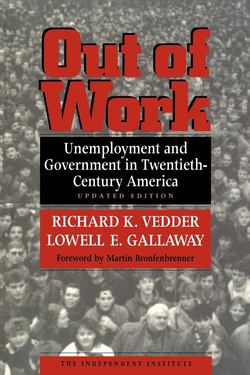Читать книгу Out of Work - Richard K Vedder - Страница 33
DATA PROBLEMS
ОглавлениеTurning to some specific potential problems in the previous statistical analysis, there are legitimate concerns about the quality of the data used. Questions have been raised about the basic accuracy of the government unemployment-rate data; the wage series used is subject to an unknown but potentially considerable amount of error, particularly before 1947; and the consumer price index has been considerably maligned by economists and others for years.
To deal with these difficulties, we reexamined the basic model outlined in equation (4), substituting alternative data sources. We used the unemployment-rate estimates for most of the period developed by Christina Romer, along with Michael Darby’s calculations for the 1930–43 period.16 We are not certain that these estimates are correct; we merely wish to see if the statistical estimation reported above is highly sensitive to which data are used.17
Regarding wages, we developed two alternative wage series. The wage information used so far derives hourly earnings by dividing annual earnings data by an estimate of average annual hours worked. The estimate of hours worked is based on a subset of the employed population, and thus may be in error. As a first alternative, we selected the wage series developed by Paul David and Peter Solar for hourly earnings for lower-skilled workers.18 The David-Solar estimates might be viewed as inferior as they relate only to one subset of the working population, unskilled workers. On the other hand, that category is particularly vulnerable historically to unemployment. Moreover, the accuracy of the data is believed to be relatively high. After 1974, we spliced hourly wage data for production workers in manufacturing to the David-Solar series. Those workers are not all unskilled, but a large proportion are.19
One might argue that the David-Solar data are a useful measure before 1947 (a period for which the data on hours worked are somewhat suspect), but that after that date the widely used BLS employee compensation data for the business sector are more appropriate, since they cover much more of the labor force and incorporate fringe benefits, not included in the David-Solar measure. Thus, a second alternative wage measure incorporates the David-Solar data up to 1947, and the BLS data subsequent to that date.
From the standpoint of the supply of labor (workers), the relevant price variable is the consumer price index or some other measure of consumer prices. Real wages are money wages related to consumer prices. Yet from the standpoint of the demand for labor (employers), the relevant price variable is some measure of producer or wholesale prices, since the marginal revenue product of labor depends in part on the selling price of goods. One could maintain, therefore, that wholesale prices should be used in calculating the adjusted real wage and as our price variable in (4). Accordingly, as an alternative price measure, we used the Bureau of Labor Statistics component of the wholesale (later, producer) price index for “finished goods.”20
With two different unemployment measures, three indicators of wage payments, and two price indices, we have twelve different possible variants on (4). Performing regression analysis on the data as before, we obtain interesting results (table 3.2). In general, the findings are relatively robust, with the explanatory power of the model varying between 78 and over 90 percent. The critically important lagged adjusted real wage variable always has the expected positive sign, and in most (nine out of twelve) cases is statistically significant at the 1 percent level (and in eleven of twelve instances, at the 10 percent level.) The model does not appear fragile with respect to the critical variable—one can alter the data in a variety of ways and still obtain results consistent with the major hypothesis that increased adjusted real wages are associated with higher unemployment.
Moreover, we consistently obtain the expected negative sign on the productivity and price change variables, with the results again being highly significant in most cases (at the 1 percent level in nine of twelve cases for the productivity variable, and in eight of twelve instances for the price variable.) Indeed, in every instance the productivity-change variable is significant at the 5 percent level.
The one factor that does not perform as well when subjected to sensitivity analysis is the change-in-money-wage variable. In only six of twelve instances does the variable have the expected sign; in only three of twelve cases are the results statistically significant. Where negative signs are obtained, however, the results are extremely weak and never different from zero in a statistical sense. It should be stressed that money wages also impact importantly on the lagged-adjusted-wage term, which is robustly and positively related to unemployment.
This exercise in sensitivity analysis confirms our faith in the basic model’s validity. In general, the results are not sensitive to definitional changes in variables. There is little doubt in our mind that unemployment varies importantly with changes in real wages adjusted for productivity change.
TABLE 3.2 TWELVE VARIANTS OF THE BASIC UNEMPLOYMENT RATE DETERMINATION MODEL 1900–89*
TABLE 3.3 THE DETERMINANTS OF UNEMPLOYMENT: AN EXPANDED ADJUSTED REAL WAGE MODEL
